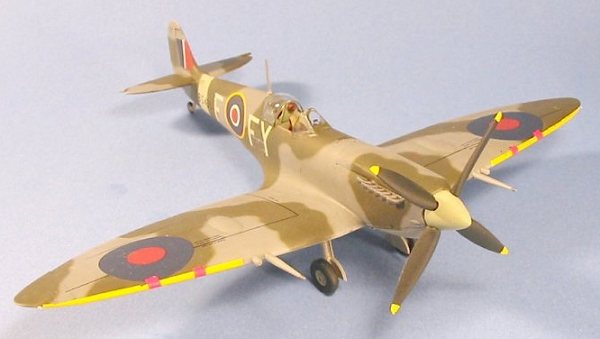
|
KIT: |
ICM 1/48 Spitfire IX/XVI |
|
KIT # |
|
|
PRICE: |
$18.95 each |
|
DECALS: |
See review |
|
REVIEWER: |
|
|
NOTES: |

|
BACKGROUND |
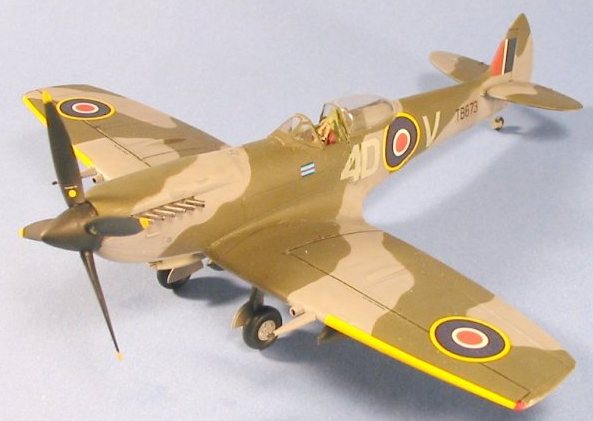
Those of you who are
long-time readers know well that I wrote a scathing review of the ICM Spitfire
IX kit when it was first released in 2001. I had personally hoped that one of
the new Eastern European companies was going to trump the big Japanese Twosome
and create a high-quality, accurate series of models of the Merlin-60 series of
Spitfires - perhaps the most-wanted of Spitfire models by modelers world-wide.
You will all recall I was most bitterly disappointed by quality control that was
a joke - indeed, it took me going through five kits that had arrived at the
local shop to find one in which the flash and short-shots of various crucial
parts was not so bad as to make the kit unbuildable; of the five, I managed to
find one, and it required clean-up of flash from every part, and puttying of bad
molds and sink marks on every part. Beyond that - I said in my review - the kit
was over-engineered, being impossible to assemble accurately if one was
unfortunate enough to try and
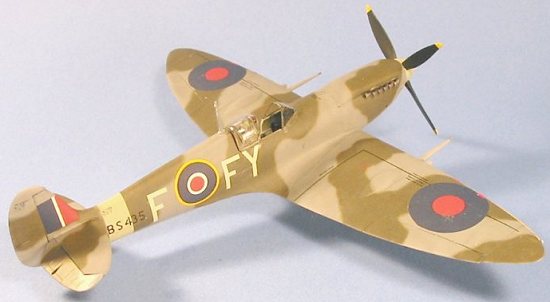 insert the engine inside the cowling, with fit of
such things as wingtips to wings being difficult when the wingtips were thinner
in cross-section than the wings. I continued, saying that a coke bottle would
provide better clarity than did the clear parts of the canopy, that the
fuselage had an incorrect cross-section of the rear fuselage, and that general
fit was such that virtually every joint needed either putty, cyanoacrylate
glue-filling of gaps, or heavy coats of Mr. Surfacer to solve the poor fit. To
top it off, the landing gear legs were too long and had to be resectioned to get
an accurate "sit."
insert the engine inside the cowling, with fit of
such things as wingtips to wings being difficult when the wingtips were thinner
in cross-section than the wings. I continued, saying that a coke bottle would
provide better clarity than did the clear parts of the canopy, that the
fuselage had an incorrect cross-section of the rear fuselage, and that general
fit was such that virtually every joint needed either putty, cyanoacrylate
glue-filling of gaps, or heavy coats of Mr. Surfacer to solve the poor fit. To
top it off, the landing gear legs were too long and had to be resectioned to get
an accurate "sit."
I personally came to the conclusion that, even with its problems in accuracy of depiction of the Spitfire IX as regards size of the spinner, length of various sections of fuselage, etc., the Hasegawa kit was far more buildable, making up in ease of assembly and accuracy of detail in the cockpit, and general overall quality, for its dimensional deficiencies. Ohhh, the flame wars that broke out over that between me and the rivet-counters!
Recently, the re-released line of ICM Spitfires made an appearance at the local shop, and out of curiosity I purchased two: the Spitfire IX and Spitfire XVI, after looking inside the boxes and seeing that one could actually recognize the parts on the sprues as actual model airplane parts and not blobs of flash.
What's different? Surprisingly, very little, but what has been changed is significant. Other than the "trenches" in front of the ailerons on the upper wings, the rest of the sink marks are gone, there are no short shots in the parts, the wingtips now fit the wings, and the quality of the plastic is improved.
Past that, the correct word for describing these kits rhymes with "witch" and starts with the letter "b."
|
CONSTRUCTION |
All the problems associated with the model are still there as regards assembly, other than the fact the parts are (mostly) molded better, without all the flash. The engine is best tossed aside; modelers who back up the cowling panel sections with Evergreen strip to provide a mating surface between the parts will have more success in assembling that particular jigsaw puzzle; the one improvement is that the side panels of the cowling now come attached to the fuselage, which improves alignment of parts.
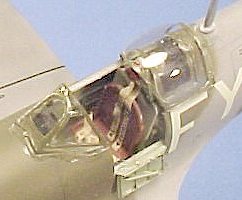
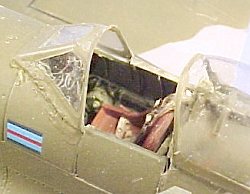 The cockpit is hopeless.
The easy solution is to pick up the True Details Spitfire IX cockpit, which
retails for about US$5.99; unfortunately, I believe this is now out of
production, so pick it up when you spot it. Other than that, virtually any
other resin Spitfire cockpit will work (I have yet to be able to identify any
"major differences" between various marks of Spitfire cockpits as detailed by
the aftermarket manufacturers - at least not in 1/48 scale; I doubt 99.99999
percent of those who view your model will be able to do so either.) I happened
to have a True Details Spit IX cockpit I used on the Spitfire IX, while using a
Cutting Edge Spitfire II cockpit for the Spitfire XVI - this required some minor dremeling of the cockpit parts and the fuselage halves to get a good fit.
The cockpit is hopeless.
The easy solution is to pick up the True Details Spitfire IX cockpit, which
retails for about US$5.99; unfortunately, I believe this is now out of
production, so pick it up when you spot it. Other than that, virtually any
other resin Spitfire cockpit will work (I have yet to be able to identify any
"major differences" between various marks of Spitfire cockpits as detailed by
the aftermarket manufacturers - at least not in 1/48 scale; I doubt 99.99999
percent of those who view your model will be able to do so either.) I happened
to have a True Details Spit IX cockpit I used on the Spitfire IX, while using a
Cutting Edge Spitfire II cockpit for the Spitfire XVI - this required some minor dremeling of the cockpit parts and the fuselage halves to get a good fit.
The canopies are
still hopeless, with the bubble canopy of the Spitfire XVI being a good
3/32-inch too short in length, which really changes the look of the completed
model. Fortunately, Squadron has vacuform canopies for the Spitfire IX and the
Spitfire XVI that are correct. These are both made by Falcon, which has its
very own set of Spitfire canopies - the "Spitfire Special" set that includes
accurate canopies for every mark and version of Spitfire made by every kit
manufacturer, so they fit right without difficulty; I highly recommend
this set to any
would-be Spitfire Boffin reading this. Falcon has two different sets of
canopy for the Spitfire IX: one fits the kit if you don't care to correct the
rear fuselage cross-section; the
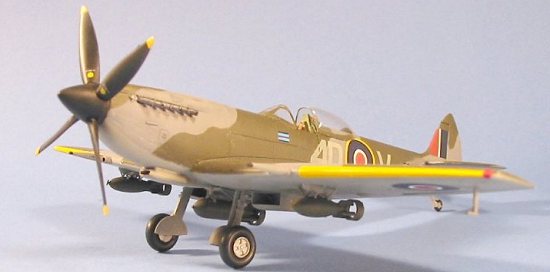 other even includes notes on the size of shim
necessary just aft of the cockpit to correct that problem, as well as the corrected-shape parts. I
used the shim and the corrected canopy on my Spitfire IX, as well as the correct
canopy on the Spitfire XVI.
other even includes notes on the size of shim
necessary just aft of the cockpit to correct that problem, as well as the corrected-shape parts. I
used the shim and the corrected canopy on my Spitfire IX, as well as the correct
canopy on the Spitfire XVI.
One must still be conscious of either not using the firewall part, or to narrow it down before attaching it, since it is overall about 1/16" too wide to fit accurately. Those who fail to fix this and force-fit the part will be rewarded with a kit that not only lacks dihedral in the wings, but will actually have anhedral when assembled. (Don't laugh - a very well-known modeler who is a good friend of mine actually did this and couldn't figure out how it had happened.)
Fortunately, using the resin cockpits did push out the fuselage halves in the vicinity of the cockpit so that - with very careful fitting before gluing - it is possible to get the wing and fuselage sub-assemblies to fit together in such a way that only a very little bit of Mr. Surfacer 500 is needed for the wing-fuselage joint, rather than the large amount of putty I had to use on the first of these I built in 2001, when I built it using the kit-supplied cockpit parts.
With both of these models, it is crucial to carefully test-fit all parts before applying glue. Do not be afraid to do some pushing and shoving - particularly when attempting the aforementioned wing and fuselage joint - to get a good parts fit.
I used left-over parts from a Hasegawa Spitfire IX for the bombs and bomb racks on the Spitfire XVI, since these were superior in quality of molding and accuracy of the bomb shapes to the parts that came in the kit.
|
CAMOUFLAGE & MARKINGS |
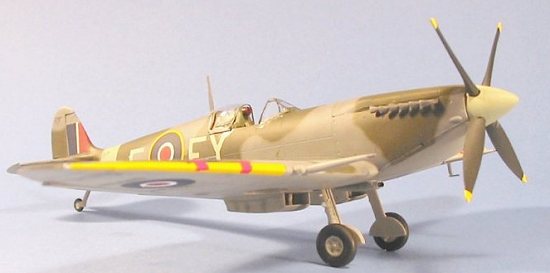 The best that can be
said for the decal sheets is that, if you are really, really hard up, either
would be a useful substitute during a toilet paper shortage. The Spitfire IX
sheet was the worst of the two; I did use the squadron codes and individual
serial number from the kit sheet on the Spitfire XVI kit. The Spitfire XVI
sheet says nothing about the non-standard upper wing insignia, which was a
standard 32-inch Type C.1 roundel as used on the fuselage of most Spitfires;
this insignia is very visible in the frequently-published photo of this
particular airplane. Fortunately, there is already a plethora of aftermarket
sheets for Merlin-60 series Spitfires, and the soon-to-be-released "Spitfire:
Aces of the Empire" from Victory Decals (to which Yours Truly made some small
contributions regarding the accuracy or the best historical guess to a few of
the markings) has markings for several Spitfire VII, VIII, and IX aces'
aircraft.
The best that can be
said for the decal sheets is that, if you are really, really hard up, either
would be a useful substitute during a toilet paper shortage. The Spitfire IX
sheet was the worst of the two; I did use the squadron codes and individual
serial number from the kit sheet on the Spitfire XVI kit. The Spitfire XVI
sheet says nothing about the non-standard upper wing insignia, which was a
standard 32-inch Type C.1 roundel as used on the fuselage of most Spitfires;
this insignia is very visible in the frequently-published photo of this
particular airplane. Fortunately, there is already a plethora of aftermarket
sheets for Merlin-60 series Spitfires, and the soon-to-be-released "Spitfire:
Aces of the Empire" from Victory Decals (to which Yours Truly made some small
contributions regarding the accuracy or the best historical guess to a few of
the markings) has markings for several Spitfire VII, VIII, and IX aces'
aircraft.
|
INDIVIDUAL MODELS |
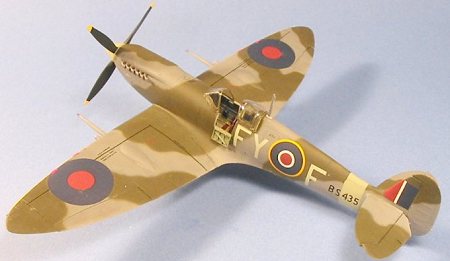 For those who really
really have to know, the two Spitfires modeled here are well-known examples of
their sub-types, from contemporary photos. The Spitfire IXB is that flown by
Squadron Leader Hugo Armstrong, OC 611 Squadron - one of the first units to be
equipped in 1942 with the Mark IX - as seen in a famous Charles Brown air-to-air
photo; this was done using Aeromaster 48-464 "Spitfires At War Part III" (now
OOP). The Spitfire XVI was flown by Squadron Leader A.J. Reeeves, OC 74
Squadron in April 1945 - 74 being one of the few units to fly the bubble-canopy
Spitfire XVI operationally before the end of the war (it only arrived at the MUs
in March-April 1945, having appeared on the production line in February). Other
than the kit decals for Squadron codes and serial number, everything else came
out of the decal dungeon.
For those who really
really have to know, the two Spitfires modeled here are well-known examples of
their sub-types, from contemporary photos. The Spitfire IXB is that flown by
Squadron Leader Hugo Armstrong, OC 611 Squadron - one of the first units to be
equipped in 1942 with the Mark IX - as seen in a famous Charles Brown air-to-air
photo; this was done using Aeromaster 48-464 "Spitfires At War Part III" (now
OOP). The Spitfire XVI was flown by Squadron Leader A.J. Reeeves, OC 74
Squadron in April 1945 - 74 being one of the few units to fly the bubble-canopy
Spitfire XVI operationally before the end of the war (it only arrived at the MUs
in March-April 1945, having appeared on the production line in February). Other
than the kit decals for Squadron codes and serial number, everything else came
out of the decal dungeon.
The models were painted with Gunze-Sangyo H-337 Blueish Grey for Ocean Grey and H-73 RAF Dark Green for the upper surfaces, and Tamiya Medium Grey for the lower Medium Sea Grey color; in all cases both colors were "faded" with Gunze-Sangyo "Violet" to simulate the ultra-violet paint fading found on aircraft used in the ETO. Tamiya "Sky" was used on the Spitfire IX.
|
CONCLUSIONS |
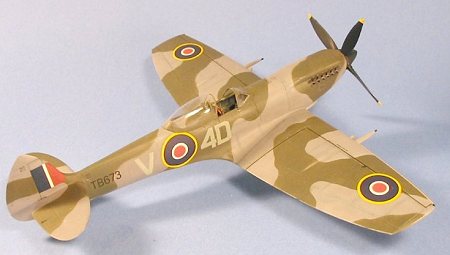 At a price under $20
for the kit, adding in another $3 for a canopy, $5-$10 for a cockpit, and $7 for
a good sheet of decals does not add up to an unreasonable sum. The end result,
with "some modeling ability required," is a model of this famous aircraft that
is dimensionally accurate, but a model that really requires the aftermarket
items if it is to be built to an acceptable quality and look.
At a price under $20
for the kit, adding in another $3 for a canopy, $5-$10 for a cockpit, and $7 for
a good sheet of decals does not add up to an unreasonable sum. The end result,
with "some modeling ability required," is a model of this famous aircraft that
is dimensionally accurate, but a model that really requires the aftermarket
items if it is to be built to an acceptable quality and look.
Be aware that some of the new kits include the set of 1/48 RAF figures ICM has also recently released, for an additional US$8.00 in price. The Spitfire IX I bought had these, and they can very easily be made up into quite realistic-looking figures that would be very useful in creating a good-looking diorama. They are also sold as a separate item, and are well worth picking up one way or the other.
As to my overall view, these ICM kits are still lacking in good production design and molding quality. I took one look at the three different Mustang kits that were also on the shelves with these Spitfires, and took a pass on all three for general crappiness of design and production; the Accurate Miniatures and Tamiya kits they were ripped-off from are far superior. Until Hasegawa "does the right thing" and redesigns the fuselage of their kit (like they did for their 109 series), you are stuck with these ICM Spitfires if you want a dimensionally-accurate model. If this sounds like I am damning these kits with faint praise, that's because I am.
Kits provided thanks to my billfold.
January 2003
If you would like your product reviewed fairly and quickly by a site that has well over 175,000 visitors a month, please contact me or see other details in the Note to Contributors.